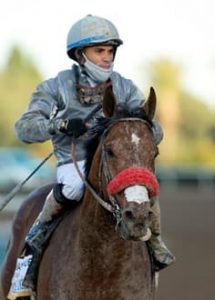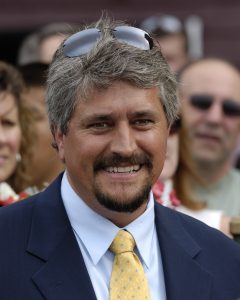By Noel Michaels
A winter storm whipped through the country last week with snow, ice, and extreme cold impacting at least 18 states from New Mexico to Maine. The effects were felt for horse racing fans in several places as the storm wiped-out racing cards all over the Midwest with several closures in its wake, including an entire week at Oaklawn Park.
Oaklawn’s canceled week of racing, Feb. 4-6, will be made up as three extra Thursday race cards on March 17, 24, and 31. The canceled Bayakoa Stakes (G3) for fillies and mares, was rescheduled for the Feb. 12 undercard that features the Razorback Handicap (G3).
With the short pause at Oaklawn, this is a good time to evaluate some elements of the that are relevant to handicappers. The meet started in Dec. 3, so we’re already two months in.
Preferred running styles and posts

Oaklawn – Photo courtesy of Coady Photography / BloodHorse
Through Jan. 30, the track has played remarkably fair. In terms of post positions, you will find really no bias in sprint races, with exactly half of them won by horses from the five inside posts (64 combined wins in 128 sprints). Horses breaking from posts 6-12 won the other 64 sprints. Sometimes even saying that a track is playing fairly can lead to a betting angle, and this is one of those times because bettors often shy away from outside posts at Oaklawn, and outside drawn horses often go off at overlay prices on the tote board and in the exotics. Don’t hesitate to bet outside horses in Oaklawn sprints all the way out to post 12.
In terms of sprint running styles at Oaklawn, 6 furlongs is generally a good distance for front-runners, who enjoy roughly a 30% winning percentage. The less used 5 ½-furlong distance is even more speed-favoring with 38% wire-to-wire.
In Oaklawn dirt routes, post positions do matter, but perhaps not to the extent that you might have thought. It’s true that the inside six posts have accounted for most of the winners at the distances of one-mile and 1 1/16 miles. A total of 66 of the 85 routes run at the meet have been won from posts 1-6, however, there have been much fewer starters from the outside posts and when you consider the winning percentages, the outside posts don’t really become disastrous until posts 11-13, which have gone a combined 0-for-38 at the current meet. Posts 7-10 are not as good as posts 1-6, but horses have been able to win from out there at least at fair percentages.
In terms of running styles in Oaklawn routes this season, about 23% of all 1-mile races were won wire-to-wire. About 28% of the 1 1/16-mile races were won wire-to-wire. The Oaklawn tried-and-true prevailing running-style bias tends toward horses with at least tactical speed who can stay on or within two lengths of the early lead.
Top jockeys

Jockey Joel Rosario guides Idol after their victory in the Santa Anita Handicap – Photo Courtesy of Benoit Photo
It comes as no surprise to see nine-time Oaklawn riding champion Ricardo Santana, Jr. leading the standings with 25 wins from 128 mounts for 20%. What is noteworthy is the continued emergence of Francisco Arrieta, who broke through last year at Oaklawn and is currently second, two wins behind Santana with 23 from 150 mounts for 15%. That total places him four wins ahead of the much more heralded Florent Geroux, who has 19 wins from 100 mounts.
The other big news in the Oaklawn jockey’s room, of course, is the return from injury of Joel Rosario, who has already made his presence felt at the meet with seven wins from his first 26 mounts for 27%. He will be out of town a lot for stakes races, but when he rides at Oaklawn you must take notice.
Oaklawn veteran Ramon Vazquez enjoyed a hot start to the meet but has cooled off lately and is currently fifth in the standings with 16 wins from 134 mounts (12%). David Cabrera leads all jockeys at the meet in mounts with 173, but he has won 18 for a win percentage a shade over 10%.
Trainer trends

Steve Asmussen – Photo by Adam Coglianese, NYRA
The 2021-22 Oaklawn training title sets up as an intriguing three-way battle between 11-time winner Steve Asmussen, Oaklawn 2020 leading trainer Robertino Diodoro, and Eclipse Award winning trainer Brad Cox. So far, the results have not disappointed, with this trio leading the way.
Asmussen has 19 victories, but his results have been disappointing for handicappers as Asmussen has started 123 runners and won only 15%. Diodoro is tied for second in wins by having the type of season expected of him with 15 wins from 76 starters for 20%. Meanwhile, it has been Cox who has been the most profitable to bet on with his 15 wins coming from 60 starters for a win percentage of 25%. It’s yet to be seen if Cox and Diodoro will be able to start enough horses at the meet to compete with Asmussen, but to date both trainers have been better bets that Asmussen in win percentage and ROI.
Beyond the big three, the best bets by winning percentage and ROI include Chris Hartmann (7-for-34, 21%), Tom Swearingen (5-for-16, 31%), Rene Amescua (4-for-15, 27%), Scott Becker (4-for-16, 25%), and Paul Holthus (4-for-17, 24%).

Noel Michaels has been involved in many aspects of thoroughbred racing for more than two decades, as a Breeders’ Cup-winning owner and as a writer, author, handicapper, editor, manager and promoter of the sport for a wide range of companies including Daily Racing Form and Nassau County Off-Track Betting.
He also is regarded as the leading source of news and information for handicapping tournaments and the author of the “Handicapping Contest Handbook: A Horseplayer’s Guide to Handicapping Tournaments”, which made his name virtually synonymous with the increasingly-popular tournament scene.
In addition to contributing to US Racing, he is also an analyst on the Arlington Park broadcast team.


